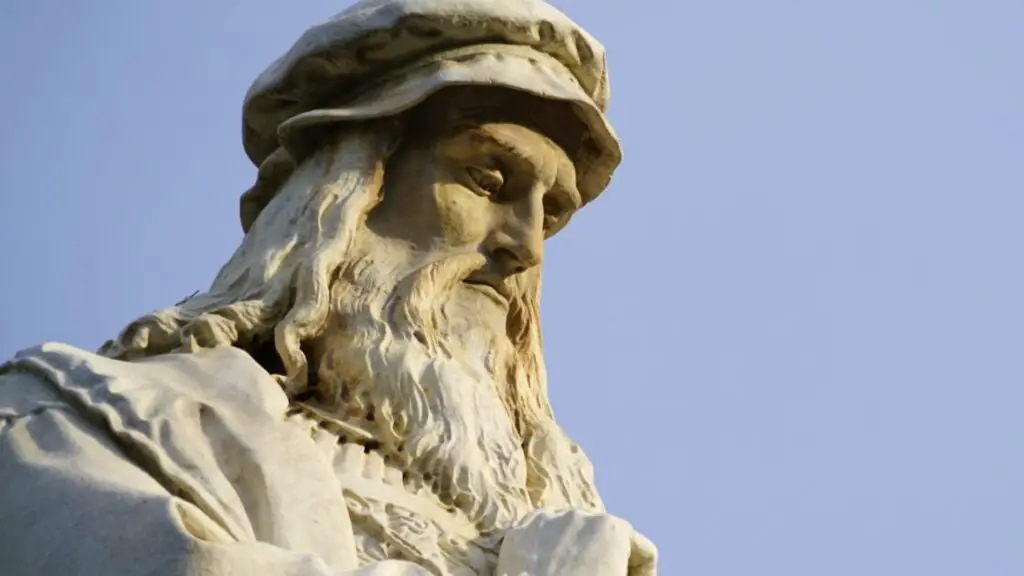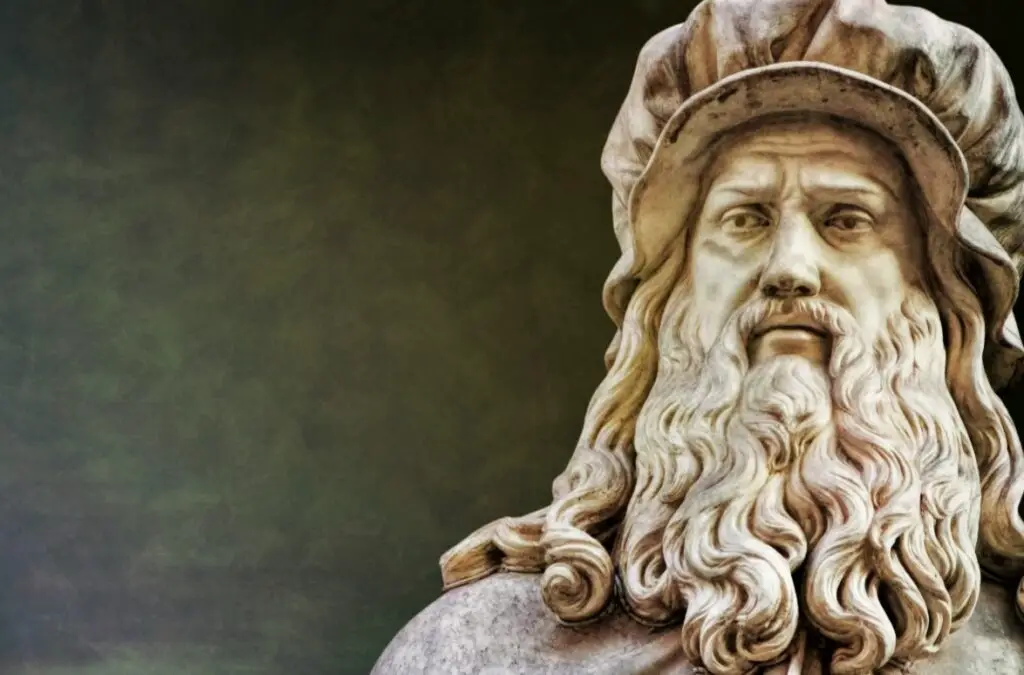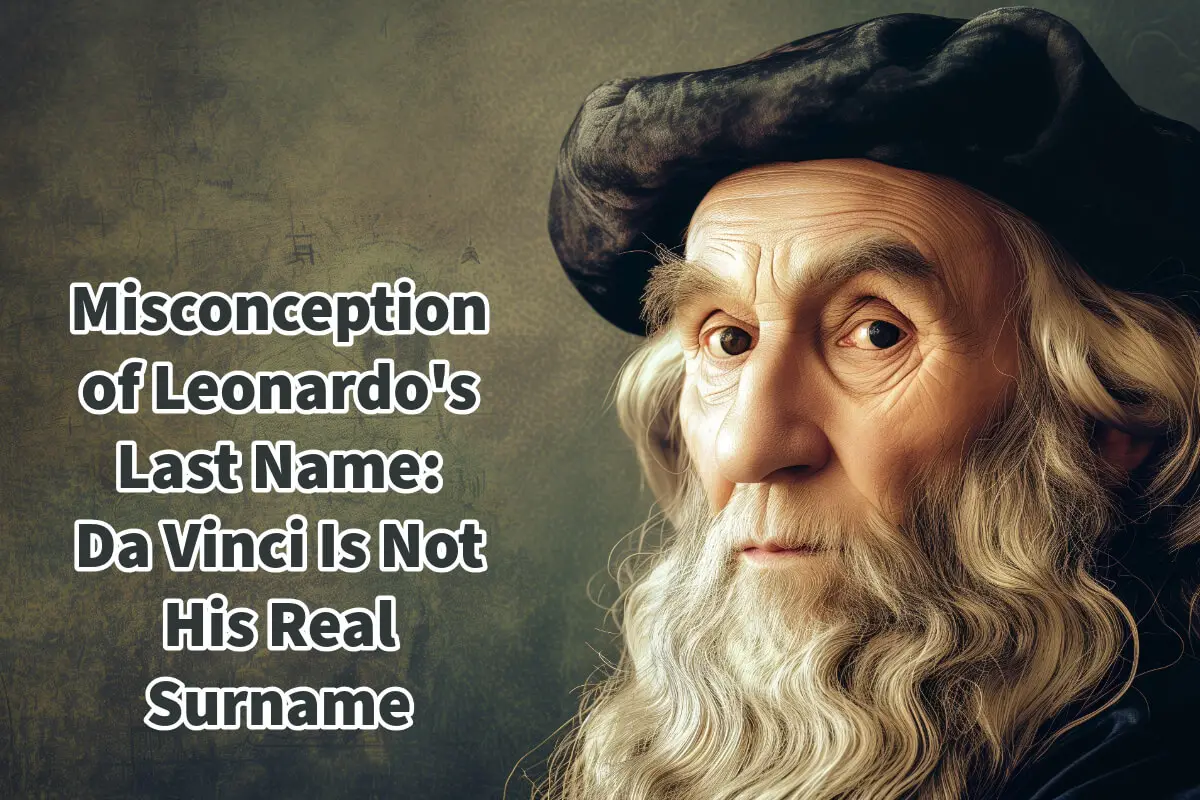When referring to one of history’s greatest minds, the name “Leonardo da Vinci” is often shortened to “da Vinci.” Yet, in doing so, we inadvertently perpetuate a common misconception.
Contrary to popular belief, “da Vinci” is not Leonardo’s last name, nor did he possess a surname in the way modern society understands them. The iconic artist, inventor, and polymath didn’t have a last name. His full name was Leonardo di ser Piero da Vinci, which translates to “Leonardo, son of ser Piero, from Vinci.” Read on as we unravel the reasoning behind this naming convention, explore Leonardo’s family background, and offer insights into why, despite his towering legacy, Leonardo didn’t carry a family surname as we know it today.
Table of Contents
- The Meaning Behind “da Vinci”
- The Concept Of Surnames In Renaissance Italy
- Leonardo’s Family: The Story Behind His Name
- Why We Call Him Leonardo “da Vinci”
- The Legacy of Leonardo da Vinci
- Leonardo: The Man Behind the Name
- Related Questions
The Meaning Behind “da Vinci”
The name “da Vinci” literally means “from Vinci,” a small village in Tuscany where Leonardo was born on April 15, 1452. Unlike today, when surnames are inherited from parents and passed down through generations, in Renaissance Italy, people often identified themselves by their place of origin, their father’s name, or even their profession.
Leonardo’s full name, Leonardo di ser Piero da Vinci, breaks down into a formula that was common at the time:
- Leonardo: His given name.
- di ser Piero: “Son of ser Piero,” with “ser” denoting that his father, Piero, was a man of some status—likely a notary or legal official.
- da Vinci: “From Vinci,” identifying where Leonardo grew up.
In this naming system, “da Vinci” functions more like an address than a family name. Think of it as calling him “Leonardo from Vinci,” much like how we refer to “Helen of Troy” or “Anne of Green Gables.” It tells us where he was from but doesn’t offer insight into a family lineage or surname in the traditional sense.

The Concept Of Surnames In Renaissance Italy
In Renaissance Italy, surnames as we know them today were not as fixed or widespread, especially among certain social classes. People were often identified by their father’s name (patronymic), place of origin, or even occupation. While noble families and wealthier individuals might have fixed family names passed down through generations, commoners or those outside the nobility often did not.
For example, other famous Renaissance figures, such as Michelangelo and Donatello, had similarly descriptive names. Michelangelo’s full name was Michelangelo di Lodovico Buonarroti Simoni, indicating he was the son of Lodovico of the Buonarroti Simoni family. Donatello, whose full name was Donato di Niccolò di Betto Bardi, followed the same patronymic structure. Raphael, whose full name was Raffaello Sanzio da Urbino, was named after his place of origin (Urbino).
Leonardo’s lack of a traditional surname reflects both his social standing and the customs of his time. Since he was born out of wedlock to a peasant mother and a legal notary father, he likely never inherited a formal family name like the aristocratic or noble classes.
Scandinavian Naming Systems Explored
This naming system was not uncommon in other parts of Europe either. In fact, in places like Scandinavia, it was customary for a child to take their parent’s first name and add “son” or “daughter” to it.
For instance, a name like Jonsson meant “son of Jon,” while Jonsdotter would have been “Jon’s daughter.” This can make family history research or genealogy work in these countries quite confusing, as multiple individuals in the same town or city could share the last name Jonsson simply because their fathers all had the same first name, Jons.
Sweden’s tradition of using patronymics, where surnames ended with the suffixes “-son” for sons and “-dotter” for daughters, was officially abolished with the Names Adoption Act of 1963. However, this practice had largely fallen out of use by the early 20th century.
From this example, we can see that naming systems without a traditional surname were not uncommon in many parts of the world, including Sweden. In fact, Sweden stopped this practice much later than many other places.

Leonardo’s Family: The Story Behind His Name
Leonardo was born to Piero da Vinci, a Florentine notary, and Caterina, a woman who was likely a peasant or possibly a slave from the Middle East. His birth was illegitimate, and this had a significant impact on his early life.
While illegitimate children were not uncommon at the time, their status often affected their inheritance rights and social standing.
His father’s family raised Leonardo in Vinci, but he was never formally acknowledged as a member of his father’s household. This social marginalization may explain why he did not have an official surname. At the time, traditional surnames were often tied to legitimate inheritance, as they were typically passed down with family wealth or property.
Despite this, Leonardo’s father, Piero, played a role in his upbringing. Although Leonardo didn’t follow in his father’s footsteps as a notary, Piero helped him secure apprenticeships and positions within the art world, most notably with the Florentine master Andrea del Verrocchio, where Leonardo honed his painting and sculpting skills.
Early Life and Education
Leonardo showed early signs of artistic and intellectual talent as a child. He received a rudimentary education that included reading, writing, and arithmetic, but he had no formal schooling beyond that.
His training as an artist began when he was around 14 years old when he was sent to apprentice under Andrea del Verrocchio, one of the leading artists of Florence at the time.
This apprenticeship in Florence marked the beginning of his illustrious career. Although he was trained as an artist, Leonardo’s interests spanned far beyond painting and sculpture. His insatiable curiosity led him to study anatomy, botany, mathematics, engineering, and many other fields, later influencing his artistic and scientific endeavors.
Why We Call Him Leonardo “da Vinci”
Today, we refer to Leonardo as “Leonardo da Vinci,” mainly because his birthplace became a key part of his identity. Unlike the practice today, where individuals commonly adopt surnames from their parents,
Renaissance figures often used various names depending on the context. In official documents, Leonardo might be referred to as Leonardo di ser Piero to emphasize his paternal lineage, but in artistic or professional contexts, his connection to Vinci was highlighted.
Furthermore, Leonardo’s fame grew, particularly after his death, so the “da Vinci” suffix became a convenient shorthand for distinguishing him from other Leonardos. In academic and artistic circles, identifying individuals by their place of origin or master’s name was common practice.
As Leonardo’s contributions to art, science, and invention became widely recognized, the “da Vinci” label stuck, even though it wasn’t technically a surname.

The Legacy of Leonardo da Vinci
While he may not have had a last name in the conventional sense, Leonardo left an indelible mark on history with his groundbreaking work.
Although he is best known for masterpieces such as the Mona Lisa, The Last Supper, and Vitruvian Man, Leonardo was much more than a painter. He was a visionary whose innovative ideas spanned multiple disciplines.
Artistic Masterpieces
Leonardo’s most famous works, including the Mona Lisa and The Last Supper, showcase his unparalleled mastery of technique and deep understanding of human emotion and perspective. His contributions to the development of sfumato, a painting technique that gradually allows tones and colors to blend into one another, revolutionized how artists approached portraiture and landscape painting.
Scientific Contributions and Inventions
Beyond his artistic achievements, Leonardo’s notebooks reveal the breadth of his intellectual pursuits. He filled pages with designs for machines, anatomical studies, and musings on everything from hydrodynamics to flight.
Many of his ideas were centuries ahead of their time.
Flying Machines:
One of Leonardo’s most famous ideas was the ornithopter, a flying machine inspired by birds’ wings. Although it was never built in his lifetime, the designs illustrate his understanding of aerodynamics and mechanics.
Leonardo’s Tank:
Another invention was his design for an armored vehicle, often referred to as Leonardo’s tank. This machine was intended to be a mobile fortress, armed with cannons and capable of traversing battlefields—an idea far ahead of its time.
Ideal City:
During a period when Europe was ravaged by disease and urban decay, Leonardo conceptualized an “ideal city.” His designs focused on sanitation, efficient transportation, and aesthetic harmony, reflecting a visionary approach to urban planning.
Despite these ambitious projects, many of Leonardo’s inventions were never realized during his lifetime. His notebooks, filled with sketches and ideas, remained largely unknown until centuries after his death. Today, they testify to his far-reaching intellect and desire to understand the world in all its complexity.
Why Leonardo Wasn’t a Prolific Creator
For all his genius, Leonardo was not particularly prolific in terms of completed works. Many of his projects, including commissions for paintings and sculptures, were left unfinished.
This can be attributed to his wide-ranging interests; he was often more interested in exploring new ideas and solving complex problems than in completing a single task. His restless curiosity led him to move from one field to another, often abandoning projects in favor of new challenges.
Leonardo: The Man Behind the Name
Ultimately, calling Leonardo “da Vinci” doesn’t capture the full complexity of his identity or legacy. He was not “Mr. da Vinci” but rather Leonardo, a man of immense curiosity and intellect whose life was shaped by his illegitimate birth, Florentine apprenticeship, and innate drive to explore the unknown.
Leonardo da Vinci is now synonymous with the Renaissance and genius. However, remember that the “da Vinci” part of his name is not a family name but a reference to his origins in the small Tuscan village of Vinci.
His legacy, however, transcends any surname, as his contributions to art, science, and innovation continue to inspire countless generations.
Leonardo di Ser Piero da Vinci is one of history’s most remarkable figures. Though he never had a conventional last name, his singular achievements ensure that his name—whatever form it takes—will never be forgotten.
Anita Louise Art is dedicated to art education, great artists, and inspiring others to find and create their art. We love art that uplifts and inspires. #ArtToMakeYouSmile! #ArtToMakeYouHappy!
If you are interested to see any of my art, you can find out more by clicking here. If you are interested in what inspires me and my paintings, you can discover more by clicking here.
We have a free newsletter and would love you to be part of our community; you can subscribe to the newsletter by clicking here. If you have any questions, I would be happy to talk to you anytime. You can reach me, Anita, by clicking here.
Subscribe to our Anita Louise Art YouTube Channel with great videos and information by clicking here.
Join us for our podcast “5 Minutes With Art.” Spend just 5 minutes a week with us to discover and learn about great art and artists. You can find out more about our podcast by clicking here.
Related Questions
Greek And Rome’s Influence On Renaissance Art
The Renaissance, as a period of rebirth, was greatly influenced by the classical ancient art of Greek and Rome. During this period, many of these works of art were also rediscovered, which led to the discovery of realism, symmetry, and harmony in the arts. Greek and Roman art also influenced the subject matter of many of Renaissance artists.
By clicking here, you can learn more by reading Greek And Rome’s Influence On Renaissance Art.
Why Was The Human Figure So Important To Renaissance Art?
The human figure was significant to the Renaissance artists; they showed the realistic human form. They understood that to show the human form adequately, they needed to study it and understand it better. The classical statues of Greek and Rome greatly influenced these Renaissance artists and their desire to depict the perfect human form. It can be said that Renaissance artist started their study of the human figure where the Greek and Roman artists left off.
By clicking here, you can learn more by reading Why Was The Human Figure So Important To Renaissance Art?.
50 + Quotes From Renaissance Artists
The renaissance was a modern time for art during the 14th, 15th, and 16th Centuries. It is also the period in European history that marked the transition from the dark Middle Ages to the modern era known as the renaissance period. We are great fans of the renaissance and many renaissance artists. So we have created for you 50+ of some of our favorite renaissance era artist quotes.
By clicking here, you can learn more by reading 50 + Quotes From Renaissance Artists.

